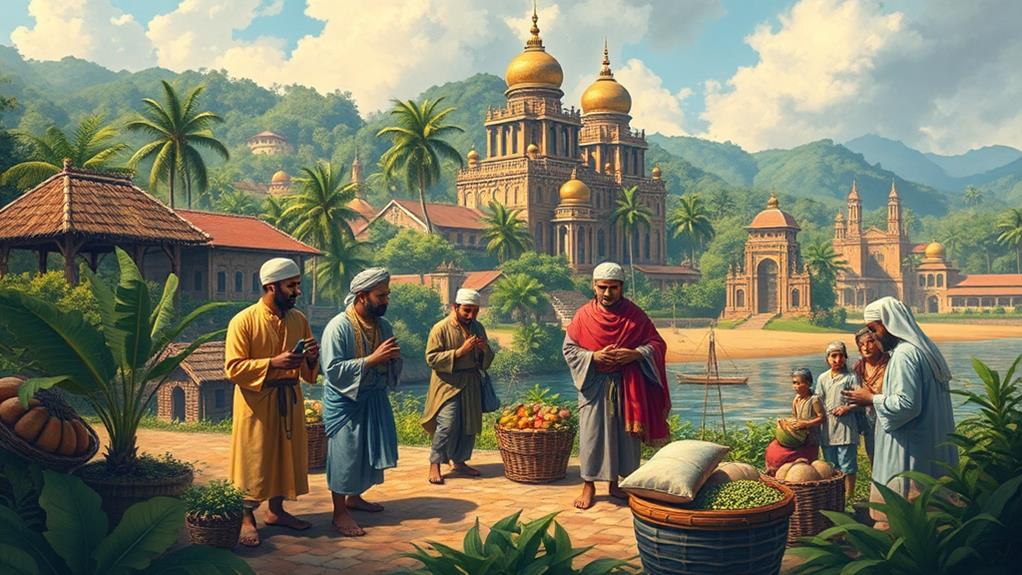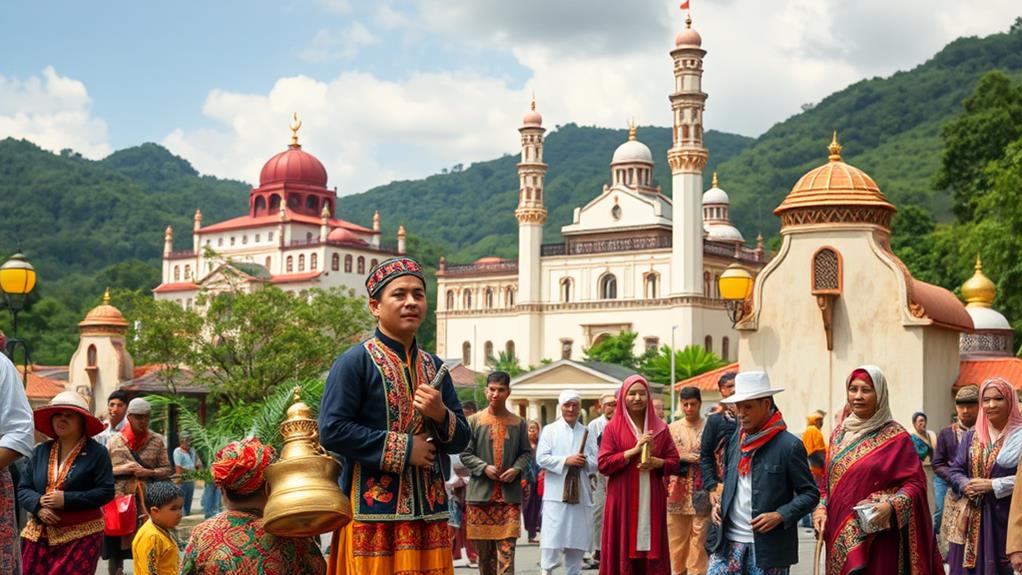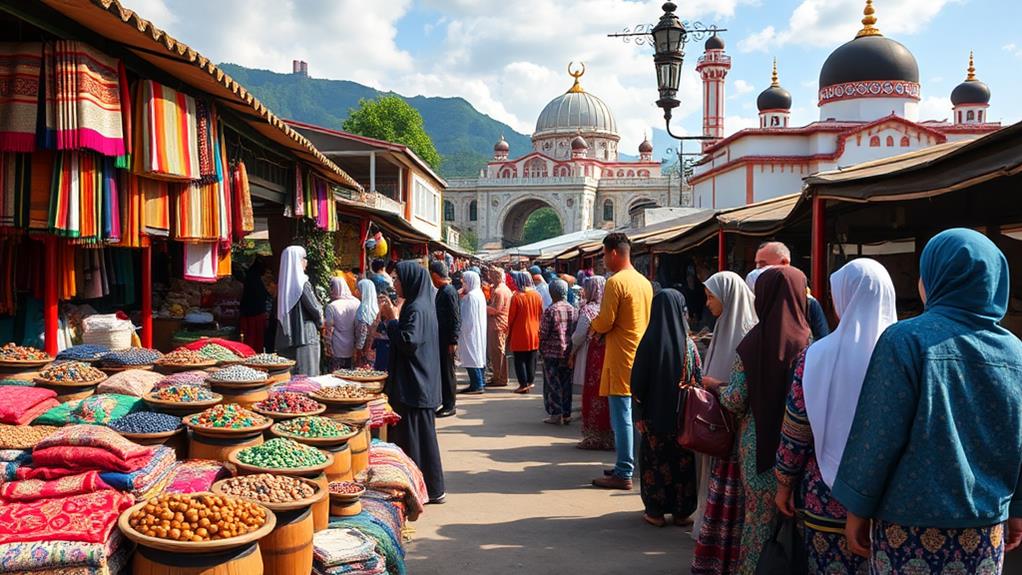Islam's Introduction in the Philippines
Islam was introduced to the Philippines in the 14th century through historical trade links. During this time, Arab traders and missionaries traveled to the islands, sharing their faith with the local population. This marked the beginning of Islam's presence in the country.
Establishment of Sultanates
Over time, Islam significantly shaped local governance and culture. The establishment of vibrant Sultanates, such as the Sultanate of Sulu and the Sultanate of Maguindanao, showcased Islamic influence on local politics.
These Sultanates were known for their rich traditions and practices, which continue to thrive today.
Spanish Suppression and Muslim Resilience
Despite Spanish suppression during the colonial period, diverse Muslim communities persisted. They continued to embody their rich traditions and practices, often in secret.
This resilience is a testament to the strength of Islamic traditions within Filipino society.
Demographics and Contemporary Challenges
Today, approximately 6.4% of Filipinos identify as Muslim, with the majority concentrated in the Bangsamoro Autonomous Region.
Contemporary challenges, such as socio-economic disparities and interfaith relations, continue to influence the Muslim landscape. These challenges require attention to ensure the continued growth and development of Muslim communities in the Philippines.
Diversity of Islamic Traditions
Exploring the history of Islam in the Philippines uncovers the resilience and diversity of Islamic traditions within Filipino society.
From the Sufi traditions of the Sulu Sultanate to the Islamic practices of the Maranao people, each community has its unique experiences and expressions of faith.
This diversity is a reflection of the rich tapestry of Islamic traditions in the Philippines.
Historical Context of Islam

Islam's Introduction to the Philippines
Islam was introduced to the Philippines in the 14th century, marking a significant cultural and religious milestone for the archipelago. This was made possible by Arab and Gujarati traders and missionaries, who established the first mosque, the Sheik Karimol Makhdum Mosque, in Simunul, Mindanao, in 1380.
Establishment of Sultanates
The establishment of the Sultanates of Sulu and Maguindanao fostered political and religious governance, allowing Muslim communities to flourish in the southern Philippines. These Sultanates played a crucial role in the spread of Islam in the region.
Spanish Colonization and Suppression
The arrival of Spanish forces in the 16th century led to a systematic suppression of Islam. The term "Moros" emerged, derogatorily labeling the Muslim population and reflecting colonial attitudes.
Despite these attempts at conversion to Christianity, the Muslim presence endured, particularly in Mindanao, Palawan, and the Sulu Archipelago.
Muslim-Led Rebellions and Modern-Day Islam
In the 20th century, Muslim-led rebellions emerged, driven by feelings of neglect and marginalization from the government. These movements aimed to reclaim political and cultural identities, resulting in various peace agreements that often left underlying tensions unresolved.
Today, according to the 2020 census, 6.4% of the Filipino population identifies as Muslim, highlighting the enduring legacy and diversity of Islam in the Philippines.
Demographics and Population Trends
The Philippines' Demographic Landscape
The Philippines is home to a diverse population with a significant Muslim presence. As of 2020, 6.98 million individuals, or 6.4% of the population, identified as Muslims. This marks a slight increase from 6.0% in 2015.
Regional Demographics
The Bangsamoro Autonomous Region in Muslim Mindanao (BARMM) has a 91% Muslim population, with 4.9 million residents. In other regions, the percentage of Muslims varies:
| Region | Percentage of Muslims |
|---|---|
| Bangsamoro Autonomous Region | 91% |
| Mindanao | Varies |
| Palawan | Estimated 10% |
| Sulu Archipelago | Estimated 85% |
| National Capital Region | 1.29% |
Ethnolinguistic Groups
Notable ethnolinguistic groups among Muslim Filipinos include:
- Iranun, Maguindanao, and Maranao in the Bangsamoro Autonomous Region
- Tausug and Yakan in Mindanao
- Palaw'an in Palawan
- Tausug in the Sulu Archipelago
- Diverse groups in the National Capital Region
Urbanization Trends
Muslim Filipinos are increasingly present in urban areas, while maintaining a strong presence in traditional regions.
Cultural Heritage and Practices

The Islamic community in the Philippines boasts a rich cultural heritage and diverse practices. This heritage reflects centuries of tradition and adaptation, as seen in the Maradika Quran of Bayang, which was declared a National Cultural Treasure in 2014.
Islamic manuscripts like the Maradika Quran hold significant importance in the region.
Sufism, introduced by early Muslim missionaries, has established key spiritual centers. For instance, the Darul Abdulqadir Jilani Dergah and Maharlika Blue Mosque are prominent centers that foster a vibrant community among followers.
These centers promote Sufi beliefs and practices, contributing to the diverse Islamic landscape in the Philippines.
The Balik Islam movement has led to a significant number of conversions to Islam. Since the 1970s, around 200,000 to 2,000,000 people, including former Christian missionaries, have converted to Islam, promoting Islamic beliefs and practices.
This movement has played a crucial role in shaping the Islamic community in the Philippines.
Revivalist movements like Tablighi Jamaat aim to revitalize Islamic practices. These movements engage communities through gatherings and outreach, deepening their understanding of the faith.
By doing so, they contribute to the dynamic nature of the spiritual and social landscape of Islam in the Philippines.
Political Landscape and Autonomy
The Bangsamoro Autonomous Region in Muslim Mindanao (BARMM) marks a significant shift in the Philippines' political landscape. In 2019, the establishment of BARMM granted political autonomy to predominantly Muslim areas in the southern Philippines, addressing historical grievances stemming from resistance against Spanish colonization and subsequent marginalization.
The 2014 Comprehensive Agreement on the Bangsamoro laid the foundation for this autonomy. This agreement, negotiated primarily with the Moro Islamic Liberation Front (MILF), recognized the need for self-determination and inclusive governance in the region.
BARMM's governance structure empowers local Muslim groups. The region has an elected parliament and a chief minister, which fosters self-determination and recognizes the diverse Muslim identities within the region. This autonomy promotes inclusive governance that respects cultural and religious distinctions.
Despite autonomy, significant socio-economic challenges persist. Communities in BARMM strive for improved infrastructure, education, and healthcare. Addressing these challenges is crucial for the region's development and stability.
BARMM plays a critical role in the broader context of Islam in Southeast Asia. The establishment of this autonomous region aims not only for peace and reconciliation but also represents a transformative moment in the political landscape of the Philippines.
How has the history and diversity of Islam in the Philippines influenced the role of mosques in Filipino Muslim life?
The role of mosques in filipino muslim life has been shaped by the rich history and diversity of Islam in the Philippines. With influences from various Islamic traditions, mosques in the country serve as important centers for religious practices, community gatherings, and spiritual guidance for Filipino Muslims.
How Does Islam in the Philippines Influence Sports and Fitness Trends?
Islam in the Philippines plays a significant role in shaping sports and fitness trends. The Muslim community’s emphasis on physical health and well-being has contributed to the popularity of activities such as traditional martial arts, like Pencak Silat, and traditional games like Sipa. These sports and fitness philippines trends continue to thrive within the Islamic community.
Contemporary Challenges and Developments

BARMM Faces Contemporary Challenges
Established in 2019 to enhance self-governance for Filipino Muslims, the Bangsamoro Autonomous Region in Muslim Mindanao (BARMM) faces various contemporary challenges that threaten its stability and development. One of the significant hurdles is the ongoing conflict with extremist groups, such as the Abu Sayyaf Group, which hinders peace efforts.
Socio-Economic Disparities Remain
Socio-economic disparities within Muslim Mindanao persist, with many communities grappling with poverty and limited access to education and healthcare. These disparities hinder their prospects for progress and create an environment conducive to extremism.
Educational Initiatives Promote Understanding
To address these challenges, educational initiatives have been launched to counter misconceptions about Islam and promote understanding among diverse populations, particularly in regions that blend Muslim and Christian areas.
These initiatives are crucial for fostering interfaith dialogue, which is essential for addressing historical tensions and building harmonious relationships across the country.
Commitment to Peace and Development
The journey toward stability in BARMM requires ongoing commitment from both the government and civil society to ensure that peace efforts aren't only sustained but also effective.
Key Literature and Academic Contributions
The study of Islam in the Philippines is enriched by a diverse body of literature that critically examines its historical, cultural, and socio-political dimensions.
Gowing's 1964 publication was the first comprehensive attempt to consolidate information on Islam in the country, detailing the history, culture, and socio-political context of Muslim tribes.
His 1978 work covered essential beliefs, practices, and secessionist movements impacting the Autonomous Region in Muslim Mindanao.
The 1968 collaborative work by Isidro and Saber provided an overview of the Islamic landscape and its rich historical roots, including the Sultanate of Maguindanao.
Jocano's 1983 essays delved into Islamization processes and social institutions, revealing the interplay between Islam and Philippine society.
These scholarly contributions significantly enhance our understanding of the multifaceted nature of Islam in the Philippines, fostering a greater appreciation for its diversity and historical significance. These works also shed light on the ways in which Islam has intersected with Filipino family traditions, revealing the complex dynamics at play in the country’s cultural heritage. Through an in-depth analysis of religious practices and historical narratives, the authors provide valuable insights into the role of Islam in shaping Filipino family traditions, offering a more comprehensive understanding of the unique blend of influences that shape the Filipino identity.
Questions and Answers
What Is the History of Islam in the Philippines?
The history of Islam in the Philippines dates back to the 14th century, when trade relations and missionary activities introduced Islamic influence to the Sulu Archipelago and Mindanao.
Arab traders and missionaries played a significant role in spreading Islam, particularly in the southern regions of the Philippines.
Spanish colonization attempted to suppress Islam, which led to resistance from Muslim Filipinos. Despite this, Islamic traditions and practices continued, with many Muslims maintaining their faith and cultural identity.
Over time, cultural integration evolved, and modern developments have aimed to address historical grievances.
The establishment of the Bangsamoro Autonomous Region is a significant example, as it honors the Mindanao heritage and seeks to promote peace and development in the region.
Why Do We Need to Study History of Muslims in the Philippines?
Understanding the history of Muslims in the Philippines is crucial to appreciate the cultural diversity of the nation. This knowledge helps individuals recognize the historical context that shapes contemporary issues.
Colonial influence has significantly impacted political relations and community dynamics. For instance, the Spanish colonization of the Philippines led to the introduction of Christianity, which often conflicted with the existing Islamic faith. This historical event continues to influence the relationships between Muslims and Christians in the Philippines today.
Studying the history of Muslims in the Philippines uncovers the significant contributions and struggles of the Muslim community. The Moro people, for example, have made substantial contributions to the country's rich cultural heritage. Their struggles, such as the fight for independence and self-governance, have shaped their identity and continue to impact contemporary issues.
Interfaith dialogue and understanding are essential for promoting peace and cooperation in the Philippines. By recognizing the historical context of Muslim-Christian relations, individuals can work towards bridging the gaps between these communities.
This understanding can help address economic disparities and ongoing conflicts, ultimately enriching the nation's diverse cultural tapestry.
How Did Islam Became the Religion and as a Way of Life of People in Mindanao?
Islam's introduction to Mindanao was facilitated by historical trade interactions. These interactions introduced Islamic influence to pre-colonial societies in the region.
The Sulu Archipelago, a vital trade hub, played a significant role in this process. As a result, Islamic teachings merged with local customs, shaping political structures and social norms.
The alignment of Islamic teachings with local customs fostered a sense of identity. This identity allowed communities to resist colonial pressures, further entrenching Islam as a way of life in the region.
What Is the Religious Diversity in the Philippines?
The Philippines is a country with rich religious diversity. This diversity is characterized by the coexistence of Christian and Muslim populations, as well as indigenous beliefs. Around 86% of the population is Christian, with the majority being Catholic. Muslims, on the other hand, make up around 6% of the population, mostly living in the southern region of Mindanao. Indigenous beliefs and practices continue to thrive, especially in rural areas.
Education and community engagement play a crucial role in promoting understanding and harmony. Many schools incorporate religious education into their curriculum, teaching students about different faiths and beliefs.
Interfaith dialogue is also encouraged through community programs and events, which help to foster greater understanding and respect among people of different religions.
Religious festivals and celebrations reflect the country's pluralism. For example, the Feast of the Black Nazarene in Manila, a major Catholic event, attracts millions of devotees.
Similarly, the Hari Raya Puasa, a significant Muslim holiday, is celebrated with feasts and festivities. These events promote cultural integration and showcase the nation's vibrant social fabric.
However, political dynamics and social issues can sometimes challenge these relationships. Conflicts between Christian and Muslim groups have occurred in the past, particularly in the southern region of Mindanao.
To address these challenges, continued dialogue and cooperation among diverse groups are essential. By promoting greater understanding and respect, the Philippines can maintain its rich religious diversity and foster a more harmonious society.